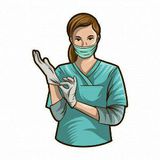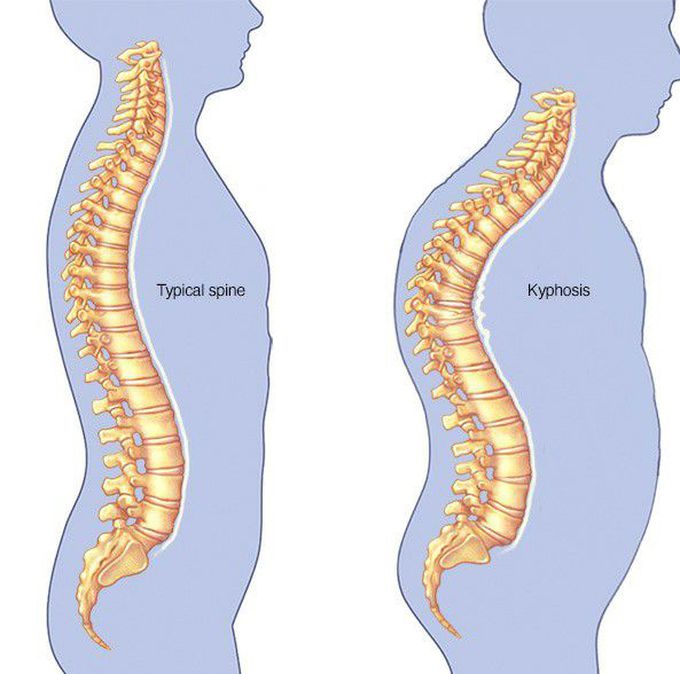


KYPHOSIS
What is kyphosis? Kyphosis is a spinal condition. In people with kyphosis, the spine curves outward more than it should. As a result, the upper back looks overly rounded. The curvature can make people looked hunched or slouching. People sometimes call it hunchback or round back. The spine has natural curves. These curves support our posture and help us stand straight. But excessive curvature can affect posture and make standing difficult. How will kyphosis affect me? Most of the time, kyphosis doesn’t cause health problems or need medical treatment. But it may make you feel self-conscious about how you look. In severe cases, kyphosis can cause pain or breathing problems. Severe kyphosis may require surgery to correct. Who gets kyphosis? Kyphosis appears more often in teenagers, whose bones are growing rapidly. But it can develop any me. It may also develop in older adults. As people age, the vertebrae lose flexibility, and the spine may begin to tilt forward. What are the types of kyphosis? The three most common types of kyphosis are postural kyphosis, Scheuermann’s kyphosis and congenital kyphosis. What is postural kyphosis? The most common type of kyphosis, postural kyphosis usually happens during the teenage years. Slouching or poor posture stretches the ligaments and muscles holding the vertebrae (spinal bones) in place. That stretching pulls the vertebrae out of their normal position, causing a rounded shape in the spine. Postural kyphosis: Has a flexible curve — changing position changes the curvature. Happens to teenagers and affects girls more than boys. Doesn’t usually cause pain or problems. What is Scheuermann’s kyphosis? This type is named after the radiologist who first identified the condition. It happens when the vertebrae have a different shape. Instead of being rectangular, the vertebrae have a wedge shape. The wedge-shaped bones curve forward, making the spine look rounded. Scheuermann’s kyphosis: Appears more often in teens and affects boys more than girls. Can be more severe than postural kyphosis, especially in people below average weight. Causes a rigid, not flexible, curve — changing position won’t change the curve. Can be painful, especially during activity or when standing or sitting for a long me. What is congenital kyphosis? Congenital means a condition you are born with. People with congenital kyphosis were born with a spine that didn’t develop properly before birth. Congenital kyphosis: Can get worse as a child grows. Typically needs surgery at a young age to stop the curve from getting worse. May be present along with other birth defects that affect the heart and kidneys. How common is kyphosis? Kyphosis happens in about 0.04% to 10% of school-age kids (up to one in 10 children, or as many as 5.6 million in the U.S.). Scheuermann’s kyphosis makes up most of those cases. Most people with kyphosis receive a diagnosis when they are 12 to 17 years old. Boys have Scheuermann’s kyphosis about twice as ofen as girls do. SYMPTOMS AND CAUSES What causes kyphosis? The cause of kyphosis depends on the type: Postural: Poor posture, leaning back in chairs, carrying heavy bags. Scheuermann’s: Problem in the spine’s structure. Congenital: Problem that developed in the spine before birth. Other causes of kyphosis include: Age, since the spine starts to curve more as people get older. Spinal injury. What are symptoms of kyphosis? The main symptom of kyphosis is having rounded shoulders or a hump in the upper back. Tight hamstrings (muscles in the back of the thigh) can also be a symptom. People who have a more severe curve may have other symptoms, including: Pain or stiffness in the back and shoulder blades. Numb, weak tingling legs. Extreme fatigue. Shortness of breath or other breathing trouble due to the spine pressing against the airways. Balance problems. Bladder incontinence or bowel incontinence. DIAGNOSIS AND TESTS How is kyphosis diagnosed? Often, a scoliosis screening at school is when a provider first notices a child’s kyphosis. Other times, adolescents or their parents notice a rounding of the spine. You should see your healthcare provider for a complete diagnosis. A healthcare provider will do a physical exam to look at the spine. The provider may ask you (or your child) to do the “Adam’s forward bend test.” You are asked to bend forward with feet together, knees straight and arms hanging free. This test helps the provider see the spine curve or any other spine problems, such as scoliosis (a sideways curve of the spine). You may have a spine X-ray to measure the curve of the spine. The natural curve is between 20 and 45 degrees. A provider will diagnose kyphosis if the curve is greater than 50 degrees. What other tests might I need? Your provider may also look for other conditions that can contribute to kyphosis. For example, in older adults, Parkinson’s disease can contribute to kyphosis. If you have a severe curve, your provider may want to do a pulmonary function test to measure how well your lungs are working. A severe curve may also compress (squeeze) your spinal cord. Your provider may notice signs of spinal cord compression, such as numbness, tingling, bladder or bowel incontinence and poor balance. They may order an MRI to get a more detailed look at your spine. MANAGEMENT AND TREATMENT How will my provider decide what kyphosis treatment I need? Treatment depends on your: Age. Medical history. Type of kyphosis. Severity of the curve. The goal of treatment is to stop the curve from getting worse. In severe cases, you may need surgery. But most people with kyphosis do not need surgery. Nonsurgical treatment methods can help instead. What are nonsurgical treatment options for kyphosis? Providers may recommend nonsurgical treatments for people with postural kyphosis. Nonsurgical options also can help Scheuermann’s kyphosis if the curve is less than 75 degrees. Treatment options include: Monitoring the curve: Regular X-rays during the teenage years keep tabs on the curve’s progress. Physical therapy: Exercises can strengthen abdominal and back muscles to relieve pain and improve posture. Other exercises can stretch tight hamstrings and strengthen other areas of the body. Pain medication: An-inflammatory medicines can relieve back pain. Back brace: Your provider may recommend a brace in rare cases. It’s most common when children who are still growing have Scheuermann’s kyphosis. Your provider will discuss the type of brace and how many hours a day to wear it. Will I need kyphosis surgery? If kyphosis causes severe pain or other symptoms that interfere with your life, surgery can help. A surgical procedure can reduce the curvature to relieve symptoms. Healthcare providers recommend spine surgery for people with: Congenital kyphosis. Scheuermann’s kyphosis with a curve of more than 75 degrees. Severe back pain, even after trying nonsurgical treatment. What happens in kyphosis surgery? The most common kyphosis surgery is spinal fusion surgery. During this procedure, your surgeon: Lines up the vertebrae in a straighter position. Bonds them together by using small pieces of bone to fill the spaces between the vertebrae. As the vertebrae heal, they fuse or join together. This procedure reduces the severity of the curve to support your body better. It prevents the curve from getting worse. PREVENTION Can I prevent kyphosis? You can take steps to prevent postural kyphosis: Maintain good posture. Strengthen abdominal and back muscles. Maintain a healthy weight. Carry bags or schoolbooks and supplies in a sturdy backpack or roller bag. Exercise to strengthen your body and stay flexible. OUTLOOK / PROGNOSIS What is the outlook for people who have kyphosis? Early diagnosis offers the best outlook. Most people with kyphosis who get diagnosed early don’t need surgery and have typical function. However, if you don’t treat kyphosis, the curve will get worse, leading to health problems. It’s important to monitor kyphosis regularly and do physical therapy to maintain a good posture. These steps help make sure the curve doesn’t worsen and interfere with your life. Can kyphosis come back? Kyphosis can return, even after treatment. Take steps to stay healthy and strong. Talk to your healthcare provider about what you can do to prevent kyphosis from coming back. LIVING WITH What else should I ask my healthcare provider about kyphosis? If you or your child has kyphosis, ask your provider: How severe is the curve? Will I need surgery? What nonsurgical treatments can help? Should I do physical therapy? How can I stop the curve from getting worse?
I’ve been living with Parkinson’s disease for quite some time, and for years, I struggled to find lasting relief. While medications offered some temporary help, the symptoms always returned and often worsened.Out of a mix of hope and hesitation, I decided to try an herbal treatment program from NaturePath Herbal Clinic. I’ll admit, I was skeptical at first. But around the fourth month, I began to notice real, steady progress.my tremors became less frequent the stiffness in my body eased My balance and coordination gradually improved It wasn’t an overnight transformation, but it was consistent and life changing. For the first time in years, I feel more in control of my body. I can move with greater freedom, sleep more peacefully, and enjoy daily activities without the constant discomfort I once accepted as normal.The improvement I’ve experienced physically, emotionally, and mentally has been nothing short of upliftings.If you're exploring natural options for managing Parkinson’s, I wholeheartedly recommend looking into NaturePath Herbal Clinic. Their approach has made a real difference in my life, and I’m truly grateful I gave it a chance. www.naturepathherbalclinic.com info@naturepathherbalclinic.com


